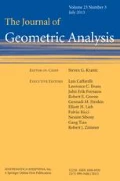Abstract
In an octonionic Hilbert space H, the octonionic inner product induces maps which fail to be octonionic linear. This fact motivates us to introduce a new notion of the octonionic para-linearity instead. To do this we encounter an insurmountable obstacle. That is, the axiom
for any octonion p and element \(u\in H\) introduced by Goldstine and Horwitz in 1964 can not be interpreted as a property to be obeyed by the octonionic para-linear maps. In this article, we solve this critical problem by showing that this axiom is in fact non-independent from others. This enables us to initiate the study of octonionic para-linear maps. We can thus establish the octonionic Riesz representation theorem which, up to isomorphism, identifies two octonionic Hilbert spaces, one of which is the dual of the other. The dual space consists of continuous left para-linear functionals and it becomes a right octonionic module under the multiplication defined in terms of the second associators which measure the failure of octonionic linearity. This right multiplication has an alternative expression
which is a generalized Moufang identity. Remarkably, the multiplication is compatible with the canonical norm, i.e.,
Our final conclusion is that para-linearity is the nonassociative counterpart of linearity.
Similar content being viewed by others
References
Baez, J.C.: The octonions. Bull. Am. Math. Soc. (N.S.) 39(2), 145–205 (2002)
Berline, N., Getzler, E., Vergne, M.: Heat kernels and Dirac operators, Grundlehren Text Editions. Springer, Berlin (2004). Corrected reprint of the 1992 original
De Leo, S., Abdel-Khalek, K.: Octonionic quantum mechanics and complex geometry. Progr. Theoret. Phys. 96(4), 823–831 (1996)
Furey, N., Hughes, M.J.: One generation of standard model Weyl representations as a single copy of \({\mathbb{R}}\otimes {\mathbb{C}}\otimes {\mathbb{H}}\otimes {\mathbb{O}}\). Phys. Lett. B, 827, Paper No. 136959 (2022)
Goldstine, H.H., Horwitz, L.P.: Hilbert space with non-associative scalars. I. Math. Ann. 154, 1–27 (1964)
Goldstine, H.H., Horwitz, L.P.: Hilbert space with non-associative scalars. II. Math. Ann. 164, 291–316 (1966)
Grigorian, S.: \(G_2\)-structures and octonion bundles. Adv. Math. 308, 142–207 (2017)
Günaydin, M.: Octonionic Hilbert spaces, the Poincaré group and \(SU(3)\). J. Math. Phys. 17(10), 1875–1883 (1976)
Günaydin, M., Gürsey, F.: Quark structure and octonions. J. Math. Phys. 14, 1651–1667 (1973)
Harvey, F.R.: Spinors and Calibrations. Perspectives in Mathematics, vol. 9. Academic Press Inc, Boston (1990)
Helgason, S.: Differential Geometry, Lie Groups, and Symmetric Spaces, Graduate Studies in Mathematics, vol. 34. American Mathematical Society, Providence (2001). Corrected reprint of the 1978 original
Horwitz, L.P., Razon, A.: Tensor product of quaternion Hilbert modules. In: Classical and quantum systems (Goslar, 1991), pp. 266–268. World Science Publisher, River Edge (1993)
Huo, Q., Li, Y., Ren, G.: Classification of left octonionic modules. Adv. Appl. Clifford Algebr. 31(1):Paper No. 11 (2021)
Jacobson, N.: Structure of alternative and Jordan bimodules. Osaka Math. J. 6, 1–71 (1954)
Lawson Jr. H.B., Michelsohn M.L.: Spin Geometry, Princeton Mathematical Series, vol. 38. Princeton University Press, Princeton (1989)
Ludkovsky, S.V.: Algebras of operators in Banach spaces over the quaternion skew field and the octonion algebra. Sovrem. Mat. Prilozh. 35, 98–162 (2005)
Ludkovsky, S.V., Sprössig, W.: Spectral representations of operators in Hilbert spaces over quaternions and octonions. Complex Var. Elliptic Equ. 57(12), 1301–1324 (2012)
Razon, A., Horwitz, L.P.: Uniqueness of the scalar product in the tensor product of quaternion Hilbert modules. J. Math. Phys. 33(9), 3098–3104 (1992)
Razon, A., Horwitz, L.P.: Projection operators and states in the tensor product of quaternion Hilbert modules. Acta Appl. Math. 24(2), 179–194 (1991)
Rembieliński, J.: Tensor product of the octonionic Hilbert spaces and colour confinement. J. Phys. A 11(11), 2323–2331 (1978)
Rudin, W.: Function theory in the unit ball of \({\mathbb{C}}^n\), Classics in Mathematics. Springer, Berlin (2008). Reprint of the 1980 edition
Salamon, D.A., Walpuski, T.: Notes on the octonions. In: Proceedings of the Gökova Geometry-Topology Conference 2016, pp. 1–85. Gökova Geometry/Topology Conference (GGT), Gökova (2017)
Saworotnow, P.P.: A generalized Hilbert space. Duke Math. J. 35, 191–197 (1968)
Schafer, R.D.: An Introduction to Nonassociative Algebras. Dover Publications, Inc., New York (1995). Corrected reprint of the 1966 original
Shestakov, I., Trushina, M.: Irreducible bimodules over alternative algebras and superalgebras. Trans. Am. Math. Soc. 368(7), 4657–4684 (2016)
Slinko, A.M., Sestakov, I.P.: Right representations of algebras. Algebra i Logika, 13(5):544–588, 605–606 (1974)
Soffer, A., Horwitz, L.P.: \(B^{\ast } \)-algebra representations in a quaternionic Hilbert module. J. Math. Phys. 24(12), 2780–2782 (1983)
Viswanath, K.: Normal operations on quaternionic Hilbert spaces. Trans. Am. Math. Soc. 162, 337–350 (1971)
Author information
Authors and Affiliations
Corresponding author
Additional information
Publisher's Note
Springer Nature remains neutral with regard to jurisdictional claims in published maps and institutional affiliations.
This work was supported by the NNSF of China (12171448)
Rights and permissions
Springer Nature or its licensor holds exclusive rights to this article under a publishing agreement with the author(s) or other rightsholder(s); author self-archiving of the accepted manuscript version of this article is solely governed by the terms of such publishing agreement and applicable law.
About this article
Cite this article
Huo, Q., Ren, G. Para-linearity as the Nonassociative Counterpart of Linearity. J Geom Anal 32, 304 (2022). https://doi.org/10.1007/s12220-022-01037-4
Received:
Accepted:
Published:
DOI: https://doi.org/10.1007/s12220-022-01037-4


